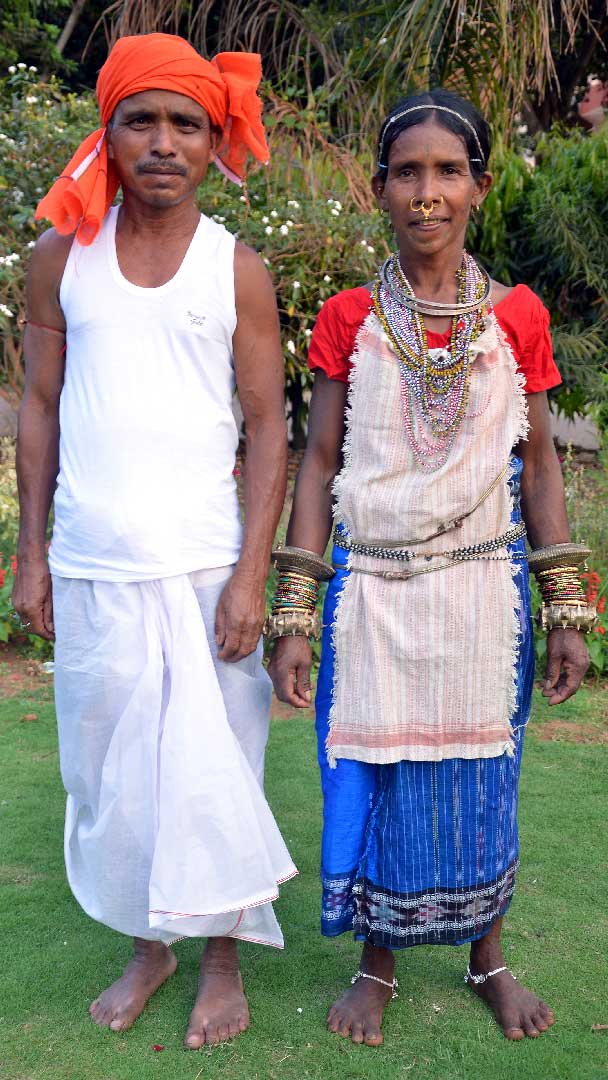TRIBES OF ODISHA
TRIBES OF ODISHA
Kutia Kandha
Region: Southern Kandhamal and Kalahandi
Population*: 8,636
Language: Kui and Kuvi
Map: Click Here
Origin: The word Kandha is derived from the Telugu word Konda meaning hill, and the community are originally hill dwellers.
Settlement: The Kutia Kandha village was traditionally uniclan with two rows of houses on either side of a wide street. The houses share a common verandah and single ridge roof, and are decorated by the women using geometric and floral motifs painted in graphite soil or red earth and lime. The shrine to the earth goddess is located at the center of the village street.
Occupation: The Kutia Kandhas are primarily shifting agriculturalists growing ragi, small millets and oil seeds. Apart from this they also engage in the collection of forest produce such as mushrooms, roots, tubers, fruits like mangoes and jackfruit during the lean season. Lac, honey, gum and leaf cups are sold in local markets to earn some extra cash. Many of the men are skilled in making bamboo mats, fish traps and baskets besides decorative tobacco containers and flutes.
*Scheduled Tribes Population as per Census 2011 data. PVTGs Population as per Micro Project Survey Data, 2010
Kutia Kandha
Region: Southern Kandhamal and Kalahandi
Population*: 8,636
Language: Kui and Kuvi
Map: Click Here
Origin: The word Kandha is derived from the Telugu word Konda meaning hill, and the community are originally hill dwellers.
Settlement: The Kutia Kandha village was traditionally uniclan with two rows of houses on either side of a wide street. The houses share a common verandah and single ridge roof, and are decorated by the women using geometric and floral motifs painted in graphite soil or red earth and lime. The shrine to the earth goddess is located at the center of the village street.
Occupation: The Kutia Kandhas are primarily shifting agriculturalists growing ragi, small millets and oil seeds. Apart from this they also engage in the collection of forest produce such as mushrooms, roots, tubers, fruits like mangoes and jackfruit during the lean season. Lac, honey, gum and leaf cups are sold in local markets to earn some extra cash. Many of the men are skilled in making bamboo mats, fish traps and baskets besides decorative tobacco containers and flutes.
*Scheduled Tribes Population as per Census 2011 data. PVTGs Population as per Micro Project Survey Data, 2010
Kutia Kandha
Region: Southern Kandhamal and Kalahandi
Population*: 8,636
Language: Kui and Kuvi
Map: Click Here
Origin: The word Kandha is derived from the Telugu word Konda meaning hill, and the community are originally hill dwellers.
Settlement: The Kutia Kandha village was traditionally uniclan with two rows of houses on either side of a wide street. The houses share a common verandah and single ridge roof, and are decorated by the women using geometric and floral motifs painted in graphite soil or red earth and lime. The shrine to the earth goddess is located at the center of the village street.
Occupation: The Kutia Kandhas are primarily shifting agriculturalists growing ragi, small millets and oil seeds. Apart from this they also engage in the collection of forest produce such as mushrooms, roots, tubers, fruits like mangoes and jackfruit during the lean season. Lac, honey, gum and leaf cups are sold in local markets to earn some extra cash. Many of the men are skilled in making bamboo mats, fish traps and baskets besides decorative tobacco containers and flutes.
*Scheduled Tribes Population as per Census 2011 data. PVTGs Population as per Micro Project Survey Data, 2010
Kutia Kandha
Region: Southern Kandhamal and Kalahandi
Population*: 8,636
Language: Kui and Kuvi
Map: Click Here
Origin: The word Kandha is derived from the Telugu word Konda meaning hill, and the community are originally hill dwellers.
Settlement: The Kutia Kandha village was traditionally uniclan with two rows of houses on either side of a wide street. The houses share a common verandah and single ridge roof, and are decorated by the women using geometric and floral motifs painted in graphite soil or red earth and lime. The shrine to the earth goddess is located at the center of the village street.
Occupation: The Kutia Kandhas are primarily shifting agriculturalists growing ragi, small millets and oil seeds. Apart from this they also engage in the collection of forest produce such as mushrooms, roots, tubers, fruits like mangoes and jackfruit during the lean season. Lac, honey, gum and leaf cups are sold in local markets to earn some extra cash. Many of the men are skilled in making bamboo mats, fish traps and baskets besides decorative tobacco containers and flutes.
*Scheduled Tribes Population as per Census 2011 data. PVTGs Population as per Micro Project Survey Data, 2010
PVTG Communities
62 Scheduled Tribes
PVTG Communities
62 Scheduled Tribes
PVTG Communities
62 Scheduled Tribes





